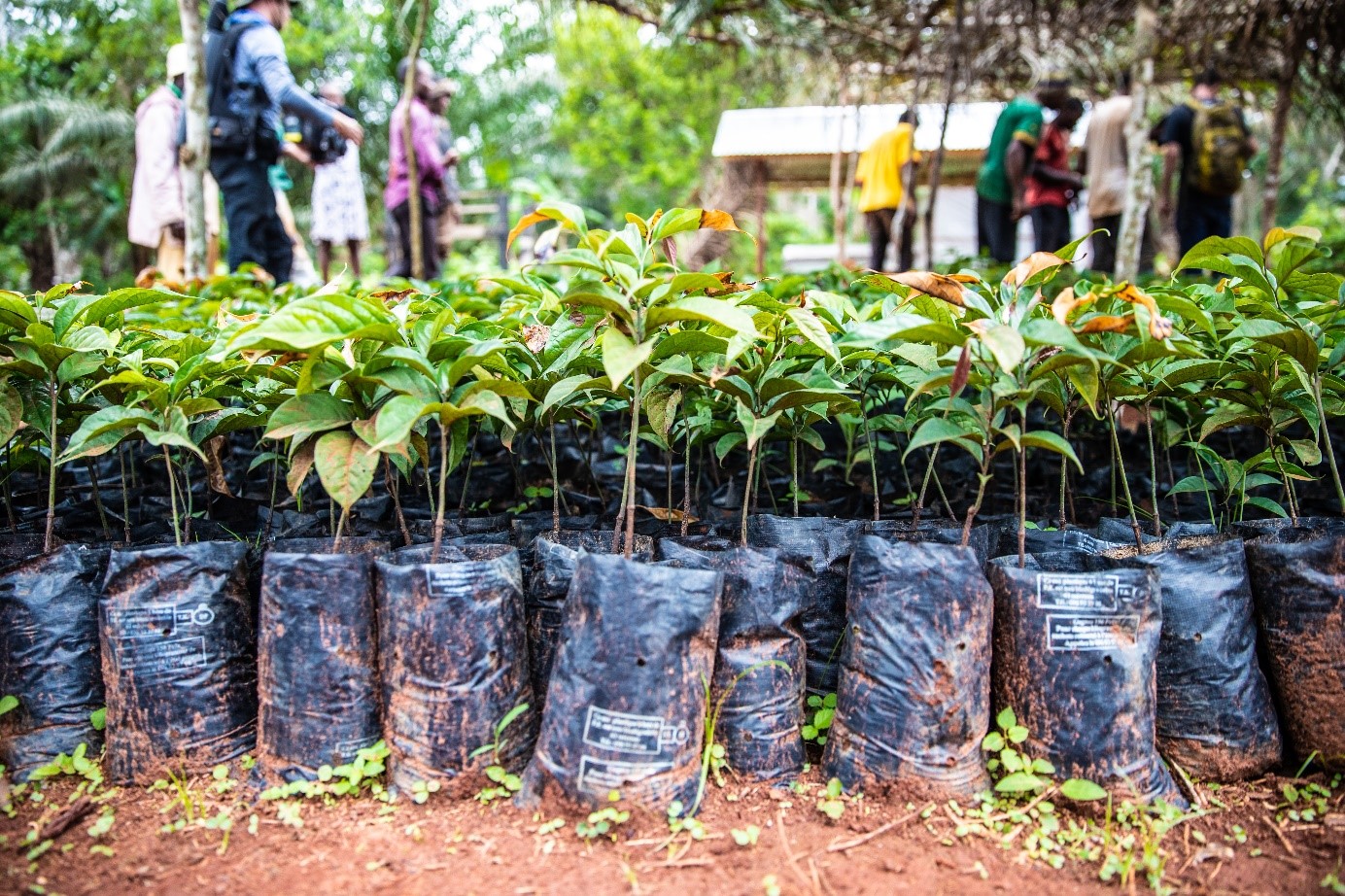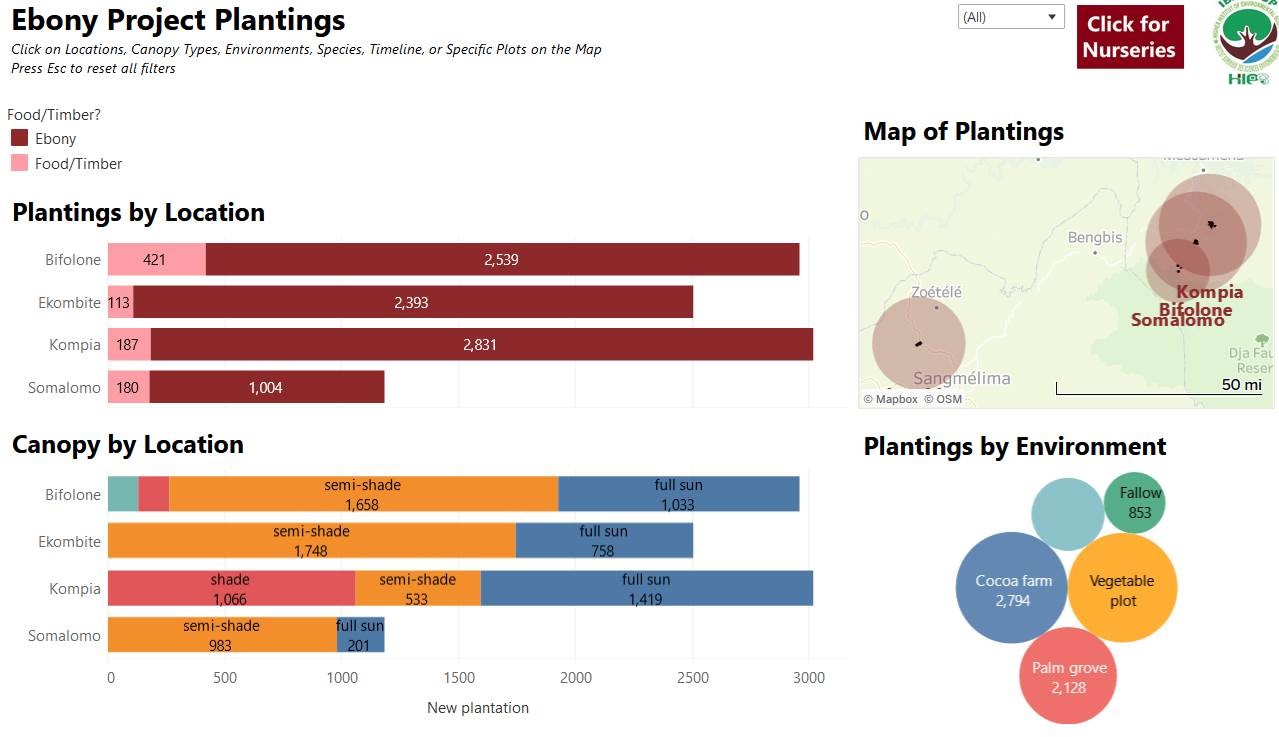Energy Services
The Ebony Project
The Ebony Project is a partnership where business, communities, and researchers work together to protect a valuable timber species, reforest degraded land, address local food security issues, and improve rural livelihoods.
To date, the Ebony Project has planted over 15,000 ebony trees and nearly 2,000 locally valuable fruit and medicine trees. The project could also lead to significant and durable carbon sequestration. In 2020, we began a partnership with UC to explore the possibility of expanding our work through the sale of offset credits to UC.
The Ebony Project overall combines three goals. First rural communities in Cameroon want good access to nutritious food and opportunities for economic growth. Second, the Congo Basin forest harbors astounding biodiversity and enormous amounts of carbon—making effective conservation in the area critically important. Third, Taylor Guitars wants to ensure that the tropical hardwood ebony is available for generations to come.
The Ebony Project is designed to address all three goals by working with communities to plant a combination of ebony trees and locally valuable fruit, medicine, and timber trees. The communities tend the trees to ensure they grow and thrive. For the first five years of participation, the project pays small stipends to the communities for this work. After the fifth year, as the locally valuable trees advance towards bearing fruit, the communities care for the trees independently, and harvest the fruits and medicines (non-timber forest products) for their own use or for sale. The project provides silvicultural booklets that record who planted what, when and where. These booklets help the project track progress, and help individual community members feel more secure in their land tenure.

There are four pillars to the Ebony Project:
- Supporting Local Communities: Communities are the foundation of Ebony Project activities. They grow, plant, and tend the trees. One of the first steps when expanding to a new community is to sign a Community Agreement. These formal, written agreements memorialize what the project will provide and what the individual/community’s obligations are in return (free, prior, and informed consent, or “FPIC”) —they are a foundational document for the Ebony Project. Participating communities are a mix of Bantu (an agrarian group) and Baka (an indigenous traditionally hunter-gather group).
- Growing and Planting Trees: The Ebony Project works with communities to build local nurseries, identify valued tree species, collect seeds, and grow plants. We also provide communities with training on nursery management, and on more advanced tree propagation techniques like marcotting. We maintain a central nursery in Yaoundé, Cameroon to supplement community nurseries and provide improved stock for more advanced propagation techniques. The communities grow the saplings until they are ready to transplant. Before the long rainy season starts, we work with individuals to identify and prepare places to plant the trees. The Ebony Project supports tree planting in fallow fields, secondary or degraded forest, and in agroforestry settings (e.g. with cacao trees). Once the saplings are planted, the individuals are paid annually for each surviving tree for five years, and project staff continue to provide technical support to communities.
- Ecological Research: As Bob Taylor said when we first started, everyone knows how to cut down ebony, but no one knows how to grow it. This project has changed that. Ebony Project researchers, led by Dr. Vincent Deblauwe, have assessed where ebony grows, under what conditions, and at what rate. They’ve determined the main pollinators of ebony, and confirmed that seed dispersers (the animals that eat ebony fruits and move ebony seeds) are critical to a healthy ebony population. This means ebony populations in forests where human hunting has eliminated most large mammals are less healthy, and face long-term challenges reproducing. They have linked ebony to another iconic species--forest elephants—which appear to be a critical seed disperser for ebony.
- Building a Road Map for Future Rainforest Restoration: The lessons learned from the Ebony Project will ultimately be translated into approaches for restoring other species of ecologically and economically important trees. This includes incorporating carbon credits into the project. In this way, the rainforests of Central Africa can be sustained and restored, contributing to the livelihoods of local communities, contributing to the conservation and preservation of the region’s high biodiversity, and providing an opportunity for carbon sequestration.
Key questions we seek to answer in the UC Offsets project include:
- How accurate are our existing estimates of the carbon sequestration potential of growing ebony trees?
- What is the best path for validation of potential credits?
- What is the pathway in Cameroon for government approval of carbon credits?

Links
The Ebony Project is part of the Congo Basin Institute, and is implemented by UCLA, the Higher Institute of Environmental Studies (HIES) in Cameroon, and the International Institute of Tropical Agriculture (IITA).
Program documents, including annual reports and peer-reviewed published articles are all available here.
Taylor Guitar’s Ebony Project microsite is available here.
⇐ Return to UC-Initiated Offsets page
